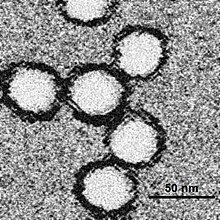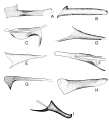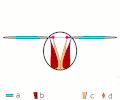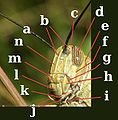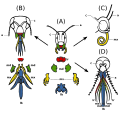Portal:Insects
The Insects Portal


Insects (from Latin insectum) are hexapod invertebrates of the class Insecta. They are the largest group within the arthropod phylum. Insects have a chitinous exoskeleton, a three-part body (head, thorax and abdomen), three pairs of jointed legs, compound eyes, and a pair of antennae. Insects are the most diverse group of animals, with more than a million described species; they represent more than half of all animal species. (Full article...)
Selected article -
West Nile fever is an infection by the West Nile virus, which is typically spread by mosquitoes. In about 80% of infections people have few or no symptoms. About 20% of people develop a fever, headache, vomiting, or a rash. In less than 1% of people, encephalitis or meningitis occurs, with associated neck stiffness, confusion, or seizures. Recovery may take weeks to months. The risk of death among those in whom the nervous system is affected is about 10 percent.
West Nile virus (WNV) is usually spread by mosquitoes that become infected when they feed on infected birds, which often carry the disease. Rarely the virus is spread through blood transfusions, organ transplants, or from mother to baby during pregnancy, delivery, or breastfeeding, but it otherwise does not spread directly between people. Risks for severe disease include being over 60 years old and having other health problems. Diagnosis is typically based on symptoms and blood tests. (Full article...)
Did you know -
- ... that molecular phylogenetics suggests that Pthirus gorillae jumped from gorillas to early humans about 3.3 million years ago and speciated into the present day pubic louse?
- ... that Austroplatypus incompertus forms colonies in the heartwood of some Eucalyptus trees and was the first beetle recognized as eusocial?
- ... that Mimoides phaon was the first swallowtail butterfly of the genus Mimoides to stray into the United States?
- ... that the "orchid dupe wasp", Lissopimpla excelsa, ejaculates visible amounts of semen as it tries to copulate with flowers of the leafless-, large- and tartan- tongue orchids, which it mistakes for a female wasp?
- ... that the oriental mole cricket, Gryllotalpa orientalis, can not only dig a burrow a metre deep but can also swim?
List articles
Related portals
General images -
Selected image -

Abantiades latipennis (Lepidoptera: Hepialidae) is one of fourteen species in the Australian genus Abantiades. It thrives in regrowth forests that were previously clearfelled; the phytophagous larvae of A. latipennis feed primarily on the root systems of two species of tree, Eucalyptus obliqua (messmate stringybark) and Eucalyptus regnans (mountain ash).
WikiProjects

Main WikiProject:
Related projects:
- WikiProject Arthropods
- WikiProject Spiders
- WikiProject Animals
- WikiProject Tree of Life
- WikiProject Biology
Daughter projects:
Tasks
 |
Here are some tasks awaiting attention:
|
Associated Wikimedia
The following Wikimedia Foundation sister projects provide more on this subject:
-
Commons
Free media repository -
Wikibooks
Free textbooks and manuals -
Wikidata
Free knowledge base -
Wikinews
Free-content news -
Wikiquote
Collection of quotations -
Wikisource
Free-content library -
Wikiversity
Free learning tools -
Wiktionary
Dictionary and thesaurus

